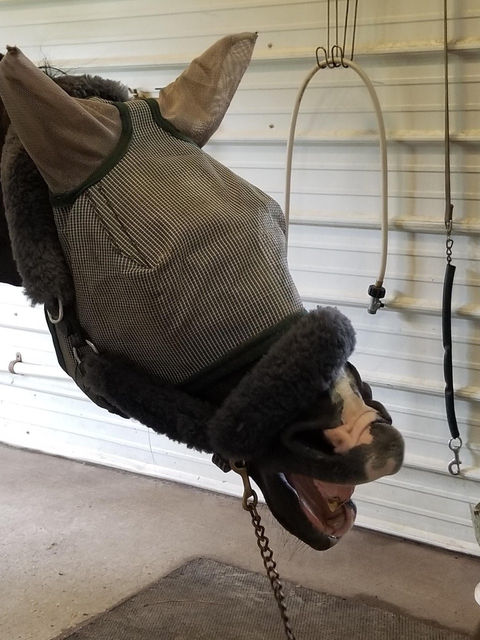


FAQ
Q: How Does This Work?
A: Horses have a tendency to mask and compensate for pain is a holdover from wild horse herds. Those that demonstrate physical weakness will be cut out of the herd, and will quickly fall prey to their natural predators. They quickly learn to hide pain, and to wall it off from their consciousness, if possible. Most horses aren’t going to show you that something hurts, unless they are completely unable to hide it. These “walled-off” areas of soreness and pain stay with the horse, create complementary problems and negatively affect performance and well-being. Mobility therapies help the horse to re-focus on these areas of tension and blockage and to let go of tension.
Imagine the horse's body is a slinky spring. When the muscles and connective tissues are lengthened and relaxed, allowing the back to raise and the hindquarters to move under the torso.
When the spring has its rings tight against one another mobility in that area is lost. This affects the entire body. This tension moves in a circular pattern; it not only contracts the surface muscles, it includes the deeper muscles and organs of the body. This affects how the horse breathes, digests food, and eliminates waste from his body.
Q: How is the work I do with EHS® different from other modalities?
A: The work I do with a horse during an Equine Hanna Somatics® session works with educating his brain to create a new pattern of communication from the neurons between the brain and the body. It teaches the horse to use his (voluntary) motor cortex rather than his cerebellum to create movement changes. This process allows the horse to let go of contractions and co-contractions in his body that created Motor Sensory Amnesia. This is literally the brain forgetting how to move a muscle in a lengthened and relaxed state. Due to the chronically contracted muscles strength is lost in that portion of the body. I work with the horse to help regain mobility and strength."
Q: What will I see when you are working with my horse?
A: During the session, you are likely to see the horse’s eye soften. He/she will may fidget – we often see yawning, head shaking, licking and chewing, as the horse lets go of internal tensions. At times you hear more noticeable gut sounds and the horse may pass gas as the GI tract relaxes. Often the shape of the horse changes the hard, flat muscles relax plumping up, as you run your hands over the skin, you are able to feel the changes if you cannot see them. After the sessions, you may observe that your horse will be bringing his nose closer to his front feet during grazing. Another lovely benefit is that your horse becomes more affectionate with you.
Q: How long does the treatment effect last?
A: That depends on each horse’s individual issue(s). Initially, results may last for a few days to a week. Over time, the positive effects are extended, depending on the horse’s lifestyle and work.
Q: How does this affect standing for farrier, vet, etc.?
A: The Mobility therapies I employ can relieve the tension that makes standing on three legs, lifting a leg, and undergoing various veterinary procedures uncomfortable. Just like us, horses get nervous and tense when they know they “are going to the doctor.”
Q: Will this reduce my need to use a vet?
A: My work is a complementary therapy to the medical diagnosis and treatment of a veterinarian, NOT a replacement. If a serious injury is suspected, a checking with your veterinarian is strongly suggested.
Q: Can I learn to do Equine Hanna Somatics® with my horse?
A: I encourage EVERYONE involved with the horses to learn basic techniques to continue the work accomplished in each session.
For anyone wanting to learn more about the Equine Hanna Somatics® movements, please consider purchasing the EHS® Session 1 video, HechterEquineMobility.com/EHSvideo.
Q: How long before a horse can be ridden or worked after a session?
A: Please schedule a rest of 24 – 72 hours depending upon the treatment received. After the initial session it is best to allow 24 hours of no work, the following 24 hours light work, after 48 hours medium work and then back to the regular schedule.
Many of the techniques used with the horse continue working with the nervous system communicating to the brain back to the muscles making the adjustments up to 72 hours. It is important to allow these communications to occur with little disruption. In subsequent sessions, the time off from work will lessen, with a few exceptions here and there.
Q: Are there any side effects I should watch for?
A: Most importantly, you should see a happier, more relaxed and potentially more playful horse. Be aware that a series of sessions is a bit like peeling an onion – when the first, most obvious issues are taken care of, other, older ones may surface. The horse’s performance and emotional well being evolve over the course of the therapy. This may manifest itself by the horse testing his body, which is now able to move differently, because tension and blockage have been decreased or eliminated. This may happen both at liberty and under saddle. As always, be open to his new signals and adjust to “ride what the horse gives you today.”




